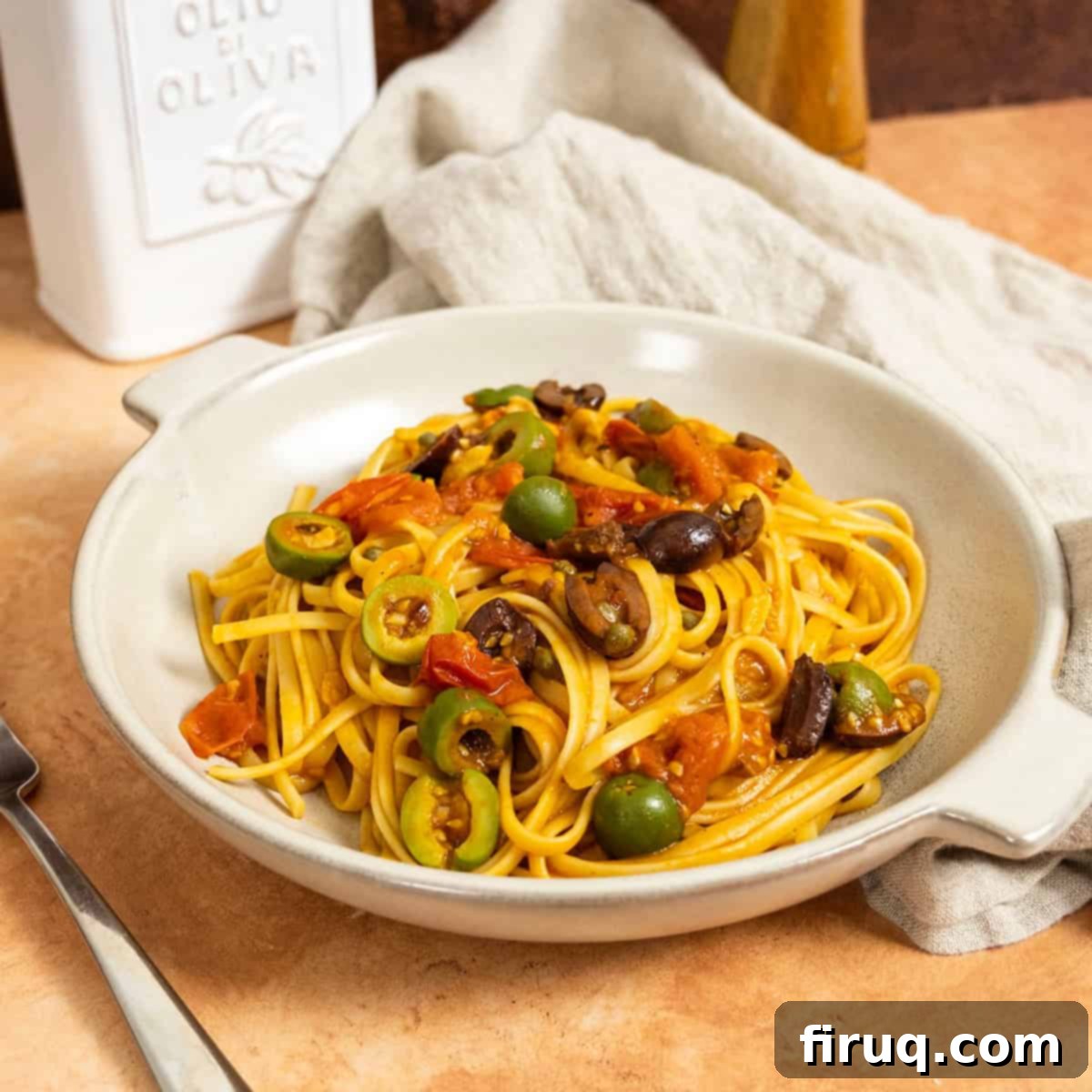Mastering Classic Linguine Alla Puttanesca: A Quick, Zesty, and Authentic Italian Pasta Dish
This classic Italian recipe truly delivers on expectations: it’s light, incredibly refreshing, and bursts with absolutely delicious flavors. Classic Linguine Alla Puttanesca is not just a dish; it’s a culinary experience that will quickly become a cherished household favorite. The best part? It’s ready to serve in under 30 minutes, making it perfect for busy weeknights or a spontaneous craving for authentic Italian fare.
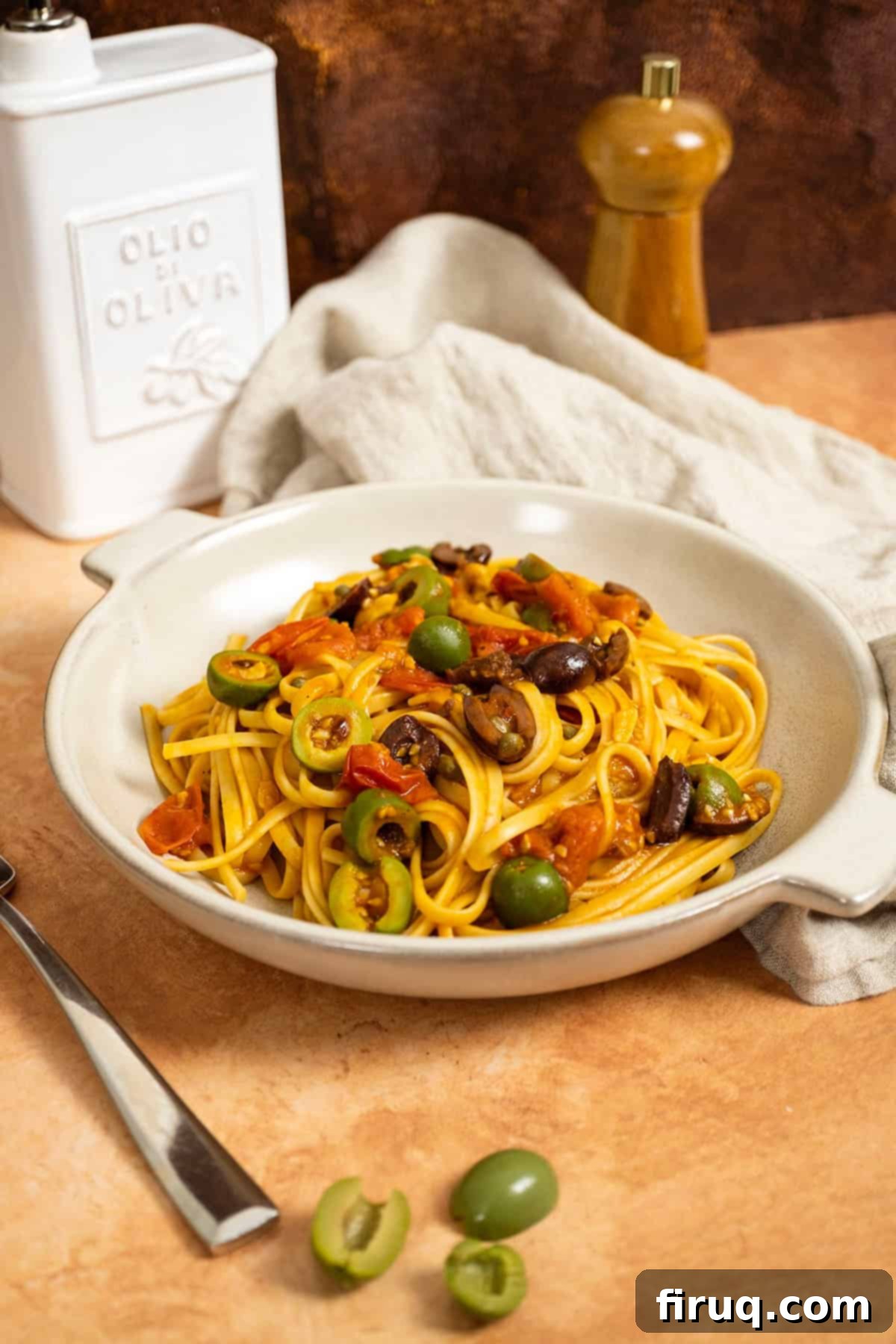
If you’re looking to explore more classic Italian pasta dishes, we highly recommend trying our Authentic Bolognese, a rich and hearty meat sauce, or our indulgent Short Rib Ragu with Gnocchi for a truly comforting meal.
This recipe brings the vibrant flavors of Southern Italy right to your kitchen. With its bold and savory profile, Linguine alla Puttanesca promises a delightful journey for your taste buds, proving that simple, high-quality ingredients are often the secret to extraordinary cuisine.
[feast_advanced_jump_to]The Intriguing Origin: Puttana or Puttanesca?
The name Linguine alla Puttanesca often sparks curiosity, deriving from the Italian word “puttana,” which loosely translates to “whore.” This provocative name has spawned several fascinating (and somewhat scandalous) origin stories, most of which revolve around the lives of prostitutes in old Italy.
One popular theory suggests that the women would prepare this dish between clients due to its quick cooking time and use of readily available pantry staples. Another tale claims the strong, aromatic scent of the sauce was intentionally used to lure men into brothels from the streets below. A third explanation suggests it was a simple, hearty meal cooked for men during their “sexcapades” as a convenient, flavorful repast.
While these “old wives’ tales” offer colorful narratives, one can’t help but wonder if they were perhaps concocted to explain away a late-night rendezvous. Imagine the scene: “Honey, I swear, I never would have entered that woman’s house, but darling, the aroma of that sauce was utterly irresistible! Once I was inside, what was I to do? Insult her by leaving?” It sounds like a convenient excuse, doesn’t it?
Whether these historical anecdotes are entirely true or merely charming folklore, they add to the mystique of classic Italian dishes like Mussels Fra Diavolo or Italian Lentils, which also carry intriguing backstories. Regardless of its scandalous past, we are always left with a truly delicious and memorable recipe that has stood the test of time!
Historically, Puttanesca sauce is believed to have originated in Naples, a city renowned for its vibrant culinary traditions. The dish embodies the spirit of Neapolitan cooking: resourceful, full of robust flavors, and utilizing simple, fresh ingredients. The combination of tomatoes, olives, capers, garlic, and anchovies creates a uniquely pungent and savory profile that is unmistakably Mediterranean.
Key Ingredients: Notes and Flavorful Substitutions
The beauty of Linguine alla Puttanesca lies in the synergy of a few humble yet powerful ingredients. Each component plays a vital role in creating its distinctive savory, salty, and slightly spicy profile. Here’s a closer look at the stars of this dish:
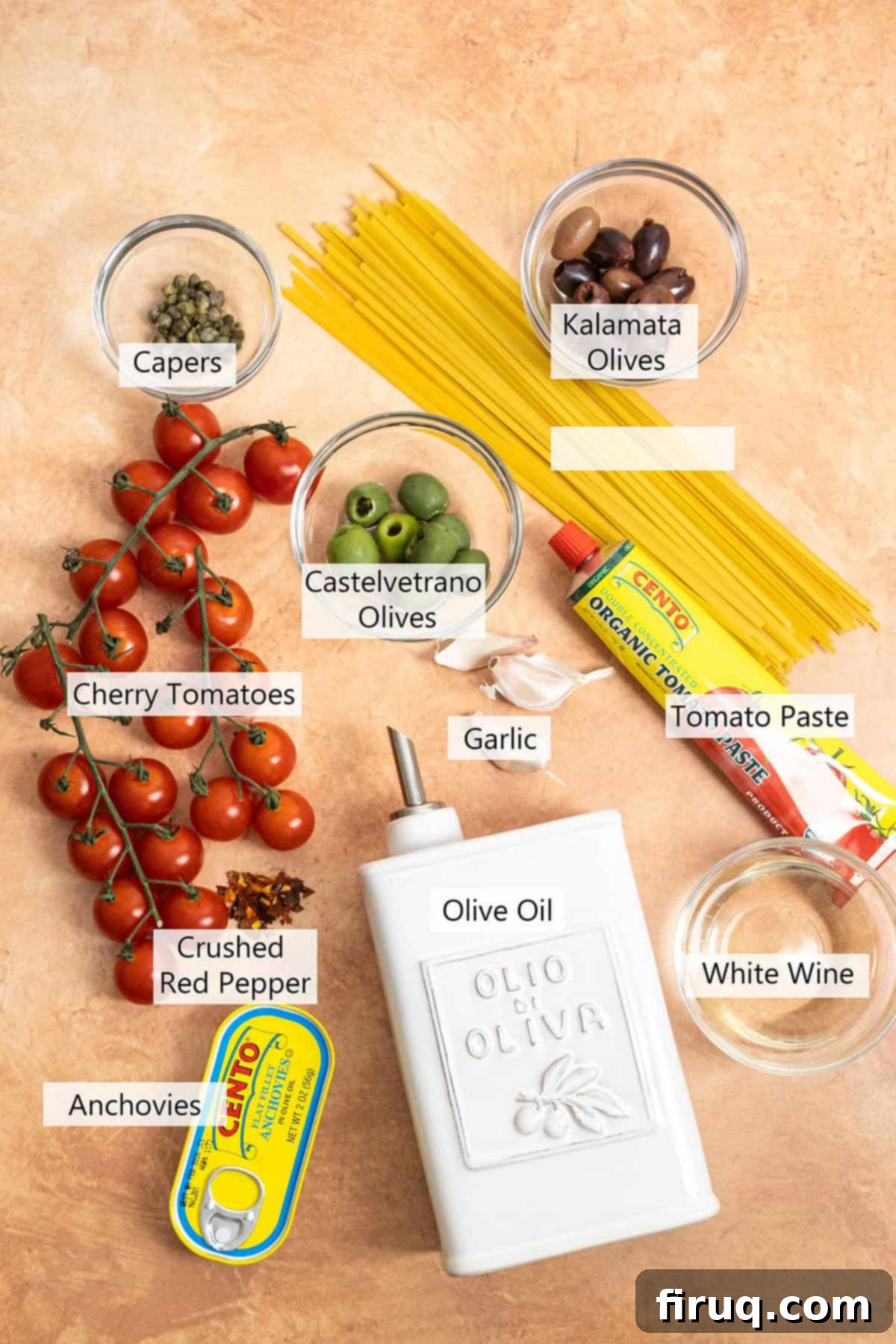
- Crushed Red Pepper: This provides a gentle heat that awakens the palate without overpowering the other bold flavors. For a deeper, slightly smoky spice, you could substitute a teaspoon of Calabrian peppers, either finely chopped or as a paste. Both options will add a fantastic kick to your dish.
- Anchovies: While some might be hesitant, anchovies are a truly necessary part of the classic Puttanesca recipe. They don’t make the dish “fishy”; instead, they melt into the sauce, providing an incredible depth of umami and a savory backbone that elevates the entire flavor profile. If you absolutely must omit them, you can, but the sauce will lose some of its characteristic richness.
- Cherry Tomatoes: We always opt for cherry tomatoes over grape tomatoes for this recipe. Their higher water content and thinner skins mean they break down much more easily, creating a lighter, fresher, and more delicate sauce. While many traditional puttanesca recipes use crushed tomatoes for a heartier texture, the cherry tomatoes contribute to a beautifully bright and vibrant sauce that feels perfect for any season. Grape tomatoes can be substituted if cherry tomatoes are unavailable.
- Olives: The choice of olives significantly impacts the final taste. We love a combination of buttery, mild Castelvetrano olives and the briny, slightly fruity Kalamata olives. This duo offers a fantastic balance of flavors and textures. However, feel free to pick whatever olives you prefer; Manzanillo olives are another great option, adding a subtly nutty and smoky note. Ensure they are pitted for ease of eating.
- Capers: These small, briny flower buds are essential for their distinctive tangy and salty punch, which cuts through the richness of the tomatoes and balances the other strong flavors. Rinse them lightly if they are very salty.
- Garlic: Fresh garlic is non-negotiable! It forms the aromatic foundation of the sauce. Slice it thinly to allow its flavor to infuse the olive oil without burning.
- Olive Oil: Use good quality extra virgin olive oil. It’s the base of the sauce and its flavor will shine through.
- White Wine: A dry white wine, such as Pinot Grigio or Sauvignon Blanc, helps deglaze the pan and adds a layer of acidity and complexity to the sauce.
*Please see the full recipe card below for precise measurements and detailed instructions on all ingredients.
How to Make the Perfect Puttanesca Sauce in Under 30 Minutes
Crafting a delectable Linguine alla Puttanesca is surprisingly simple and incredibly quick, making it an ideal choice for a satisfying meal in less than half an hour. This robust yet light sauce can serve as the perfect late-night indulgence or a brilliant side dish for heartier mains like Crispy Italian Chicken Cutlets or tender Cast Iron Boneless Pork Chops.
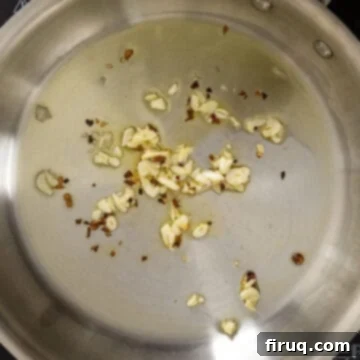
Step 1: Build the Aromatic Base. Begin by heating a spacious frying pan over medium heat. Add the olive oil, and once it starts to shimmer, indicating it’s perfectly warmed, introduce your sliced garlic and crushed red pepper. Sauté these aromatics for just 1 minute, allowing their flavors to gently infuse the oil without burning the garlic. This initial step is crucial for creating a fragrant foundation for your sauce.
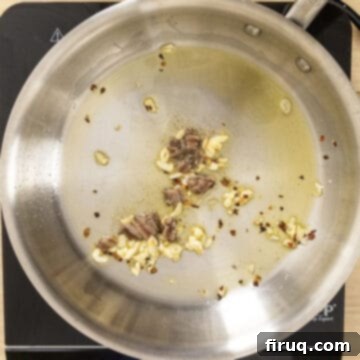
Step 2: Introduce the Umami Powerhouse. Next, add the chopped anchovy fillets to the pan. Stir frequently for another 2 minutes. As they cook, the anchovies will miraculously begin to break down and dissolve into the hot olive oil, leaving behind a profound savory depth rather than an overt “fishy” taste. This is where the sauce truly starts to develop its complex, irresistible character.
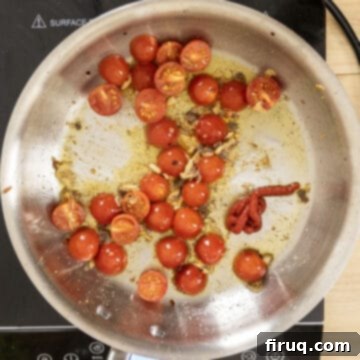
Step 3: Develop Tomato Richness. Now, add the halved cherry tomatoes and tomato paste to the pan. Stir frequently for about 5 minutes. Resist the urge to crush the tomatoes immediately; let them start to break down on their own, naturally releasing their sweet juices into the developing sauce. Once they’ve softened, you can gently press them with a spoon to aid the process. Then, pour in the white wine, bringing the mixture to a gentle simmer for another 5 minutes. This step is also the perfect time to get your pasta water boiling in a separate large pot, ready for your linguine.
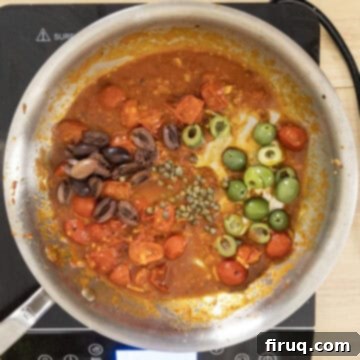
Step 4: Add the Signature Zing. Once the sauce has simmered, stir in the capers, olives, and salt. These ingredients bring the distinctive briny and tangy notes that define Puttanesca. As your pasta boils, remember to scoop out a ¼ cup of the starchy pasta water before straining. This pasta water is a chef’s secret weapon, helping to emulsify the sauce and ensure it clings beautifully to every strand of linguine.
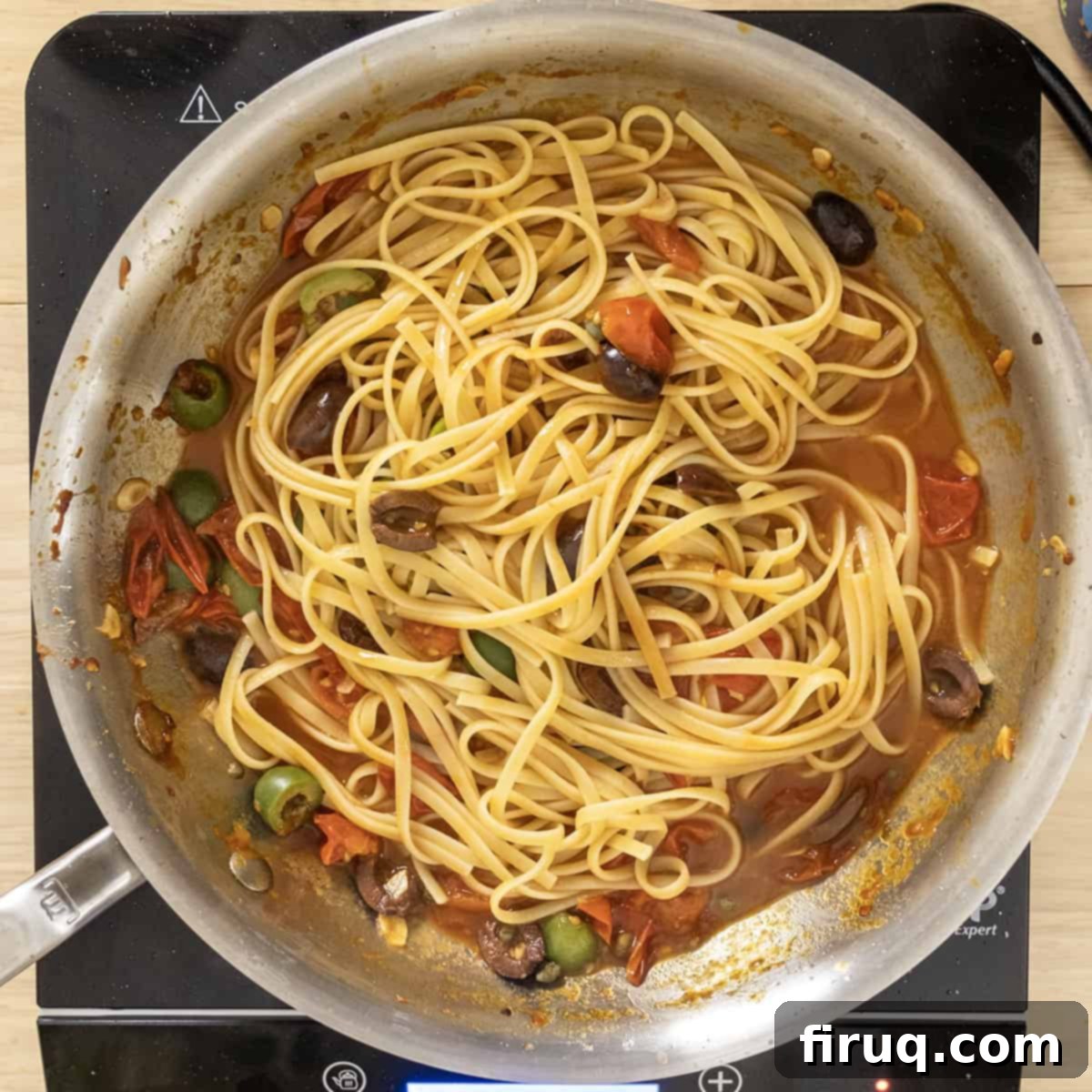
Step 5: Marry Pasta and Sauce. Once your linguine is al dente, strain it (remembering to reserve that pasta water!) and immediately transfer it to the saucepan with your simmering puttanesca sauce. Stir vigorously, allowing the pasta to finish cooking directly in the sauce. This final step is crucial; it helps the pasta absorb the vibrant flavors of the sauce and creates a wonderfully cohesive dish where every bite is infused with the rich, savory, and zesty notes of Puttanesca.
There’s a reason why this classic linguine alla puttanesca is a perennial favorite. It’s a beautifully light sauce, yet it boasts an incredibly complex flavor profile that truly satisfies. Whether it’s the crisp days of winter or the warm evenings of summer, this dish fits perfectly. Its unbelievably simple preparation highlights the amazing philosophy behind Italian food: the simplicity of high-quality ingredients is what makes it so profoundly good. A drizzle of good olive oil, fragrant fresh garlic, and savory anchovies are the humble heroes that make this easy recipe taste absolutely unbelievable.
Quick seafood pasta recipes like Linguine alla Puttanesca, or our delightful Creamy Pesto Shrimp Pasta, are perfect solutions for weeknight meals. They can be elegantly served alongside a straightforward main course such as a Classic Pork Chop Milanese or flavorful Chicken Spiedini, rounding out a perfect Italian dinner.
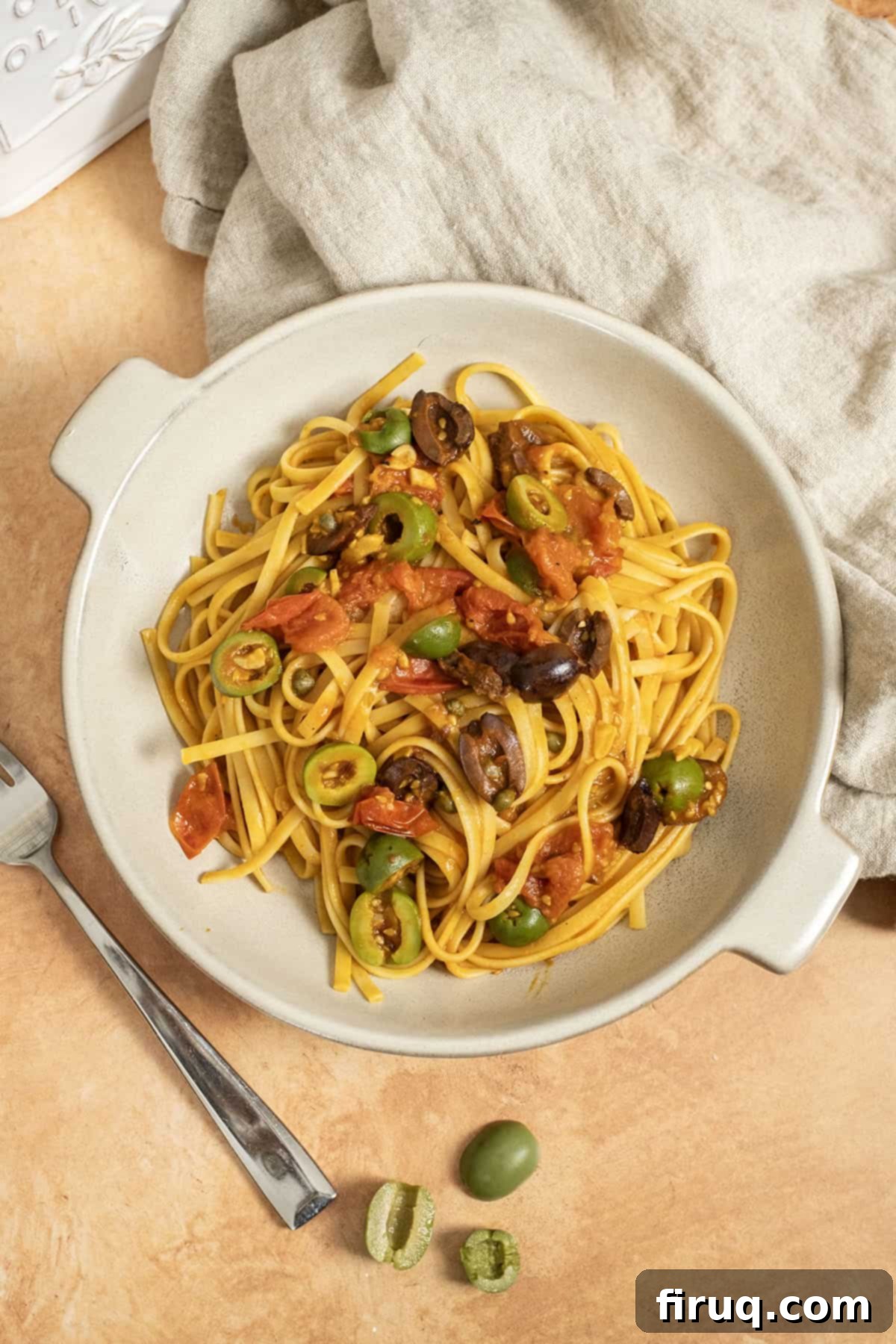
Pro-Tips for a Perfect Puttanesca
Achieving a truly exceptional Puttanesca is all about technique and understanding how each ingredient contributes to the final masterpiece. Here are some expert tips to ensure your dish is nothing short of perfect:
- Develop the Tomato Paste Flavor: Don’t rush this step! Allow the tomato paste to sit and gently caramelize in the saucepan for a few minutes before mixing it with the cherry tomatoes. This process deepens its sugars, creating an intense aroma and a more profound, concentrated tomato flavor that adds wonders to any dish. It’s a small step that makes a huge difference.
- Let Cherry Tomatoes Break Down Naturally: Patience is key here. Allow the cherry tomatoes to break down on their own without crushing them immediately. This approach helps you gauge when their walls have softened and burst, naturally releasing their sweet juices and contributing to the sauce’s body and fresh taste. You can gently press them with a spoon once they’ve begun to soften.
- Anchovies Will “Melt Away”: If you’re hesitant about anchovies, rest assured. The anchovies will melt seamlessly into the sauce, completely disappearing visually. Their role is to provide a rich, savory umami depth, not a fishy flavor. Don’t worry about them being distinctly “part of the sauce” in terms of texture; they’re there for pure flavor enhancement.
- Always Add Pasta Water: This is a non-negotiable step for a truly great pasta sauce. Make sure to add pasta water while the sauce is cooking and especially when combining the pasta with the sauce. The starch released from the pasta into the water acts as a natural emulsifier, helping the sauce stick to the pasta beautifully and creating a luxurious, cohesive texture.
- Toast Your Garlic: Ensure your garlic is gently toasted, not burned. Burnt garlic can impart a bitter taste, ruining the delicate balance of the sauce. Sauté it until fragrant and lightly golden.
Recipe FAQs
No, not in a distinctly “fishy” way. The anchovies melt down completely into the sauce, leaving behind a deep, savory, umami flavor that enriches the overall dish. They primarily contribute to the sauce’s saltiness and complexity, accentuating the tomato, caper, and olive flavors rather than standing out as a separate ingredient.
Store any leftovers in an airtight container in the refrigerator for up to 3-4 days. To reheat, gently warm the pasta in a frying pan on medium-low heat with a splash of olive oil or a little extra pasta water to help loosen the sauce and bring it back to life.
The term “Puttanesca” is derived from the Italian word “puttana,” which translates to “whore.” Hence, the most direct translation is “in the style of the whore.” This name is linked to various theories about its origin, often suggesting it was a quick, aromatic dish prepared by prostitutes in old Naples.
While our recipe uses linguine, which is excellent for its ability to cling to the sauce, spaghetti is another very traditional choice. Bucatini, with its hollow center, also works wonderfully to capture the flavorful sauce. Ultimately, a long, thin pasta is ideal for this kind of light, yet richly flavored, sauce.
Absolutely! While anchovies are a key component for authentic umami, you can omit them for a vegetarian version. To compensate for the lost depth, consider adding a pinch of dried porcini mushroom powder, a dash of soy sauce (for gluten-free options, tamari), or even some finely chopped sundried tomatoes to enhance the savory notes.
More Classic Italian Pasta Recipes to Savor
If you’ve fallen in love with the vibrant flavors and simple elegance of Linguine alla Puttanesca, you’ll surely enjoy exploring other beloved pasta dishes from the heart of Italy. Each offers a unique taste of tradition and culinary heritage, perfect for expanding your repertoire:
- Linguine with Clams
- Garlic Anchovy Pasta with Toasted Breadcrumbs
- Pasta alla Norma (A Sicilian Dish)
- Bucatini Amatriciana
We absolutely love hearing from you! Please feel free to leave a comment and a star rating below in the recipe card if you try this fantastic Linguine Alla Puttanesca. Your feedback means the world to us and helps other home cooks discover delicious new meals. Don’t forget to tag us on Instagram @vindelgiudice when you share your creations!
Embrace the simplicity and bold flavors of Italian cooking with this quick and easy Puttanesca. It’s more than just a meal; it’s a testament to how humble ingredients can come together to create something truly extraordinary.
📖 Recipe
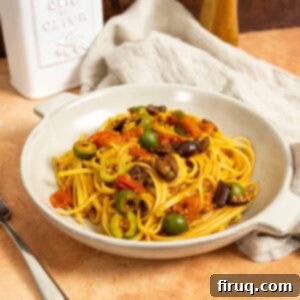
Classic Linguine Alla Puttanesca
Vincent DelGiudiceEquipment
- 1 large saucepan
- 1 large pot
Ingredients
- 1 lb linguine
- 2 tablespoon olive oil
- 6 cloves garlic, sliced
- 8 anchovy filets, chopped
- 1 teaspoon crushed red pepper
- 2 cups cherry tomatoes, halved
- 3 tablespoon tomato paste
- 1 cup white wine
- ¼ cup chopped kalamata olives
- ¼ cup chopped castelvetrano olives
- 3 tablespoon capers
- 1 teaspoon salt
Instructions
- Heat a frying pan to medium heat. Add the olive oil. Once the olive oil is shimmering, add garlic and crushed red pepper. Saute both for 1 minute. Add chopped anchovies and stir frequently for another 2 minutes.
- Add in halved cherry tomatoes and tomato paste and stir frequently for about 5 minutes until the tomatoes begin to break down. Then, add the white wine and bring it to a simmer. Simmer for 5 minutes.
- In a large pot, boil linguine until al dente. Save some pasta water.
- Stir in the capers, olives, and salt. Add a ¼ cup of the pasta water while the pasta is cooking.
- Strain the pasta and transfer it to the saucepan. Stir to finish cooking the pasta in the sauce and allow it to soak up some of the sauce.
- Remove from the pan and serve.
Notes
- Develop the tomato paste flavor by allowing it to sit in the saucepan and caramelize before mixing it with the cherry tomatoes. It adds an intense aroma and flavor of tomato that adds wonders to any dish.
- Allow the cherry tomatoes to break down on their own without crushing them so that you know when the tomato wall starts to break down.
- The anchovies will melt into the sauce. Don’t worry about too much about them being part of the sauce.
- Make sure to add pasta water while the sauce is cooking. The starch in the pasta water will make it easier for the sauce to stick to the pasta.
